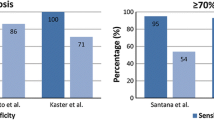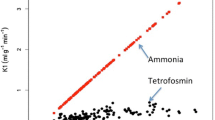Abstract
Extent and frequency of viable tissue in myocardial segments yielding a perfusion defect on technetium-99m methoxyisobutylisonitrile (99mTc-MIBI), single photon emission tomography (SPET) at rest was prospectively investigated with 2-18F-2-deoxyglucose (18FDG) positron emission tomography (PET) in 46 patients with chronic coronary artery disease (CAD). Of these, 43 had a history of old myocardial infarction. For comparative visual and quantitative evaluation of identical anatomical slices, PET image files were converted into the SPET file structure and into the same matrix size. SPET and PET images were documented and visually (9 segments/patient) or semiquantitatively evaluated by a target-like polar map. Relative perfusion was expressed in percentage of peak 99mTc-MIBI uptake. Sample 18FDG uptake was related to the 18FDG uptake in the area of such maximal perfusion (18FDG uptake was 100% at the 100% 99mTc-MIBI uptake area). Of 414 segments, 167 (40%) revealed a resting perfusion defect. 18FDG uptake was present in 38 (23%) of the defects, while another 40 (24%) segments yielded 18FDG uptake in the periphery of the defect. When grouped according to the degree of 99mTc-MIBI uptake-reduction (in percentage of peak activity), 80% of severe defects (≤30% of peak uptake), 48% of moderate (31%–50% of peak uptake) and 31% of mild (>50% of peak uptake) defects were considered as non-viable on the basis of 18FDG uptake. Complete viability was found in none of the severe defects in contrast to 29% of moderate and 35% of mild perfusion defects. From these data we conclude that 99mTc-MIBI uptake as a myocardial perfusion marker underestimates myocardial viability in patients with chronic CAD and after myocardial infarction. Nevertheless, only moderate reductions of 99mTc-MIBI uptake seem to imply a greater likelihood for viability. Comparative analysis of metabolism and flow is possible with different tomographic systems and is valuable for clinical evaluation of the cardiac patient.
Similar content being viewed by others
References
Braunwald E, Rutherford JD (1986) Reversible ischemic left ventricular dysfunction: evidence for “hibernating” myocardium. J Am Coll Cardiol 18:1467–1470
Brundage BH, Massie BM, Botvinik EH (1984) Improved regional ventricular function after successful surgical revascularization. J Am Coll Cardiol 3:902–908
Brunken R, Tillisch J, Schwaiger M, Child JS, Marshall R, Mandelkorn M, Phelps ME, Schelbert HR (1986) Regional perfusion, glucose metabolism, and wall motion in patients with chronic electrocardiographic Q wave infarctions: evidence for persistence of viable tissue in some infarct regions by positron emission tomography. Circulation 73:951–963
Brunken R, Schwaiger M, Glover-McKay M, Phelps ME, Tillisch J, Schelbert HR (1987) Positron emission tomography detects tissue metabolic activity in myocardial segments with persistent thallium perfusion defects. J Am Coll Cardiol 10:557–567
Brunken R, Kottou S, Nienaber CA, Schwaiger M, Ratib OM, Phelps ME, Schelbert HR (1989) PET detection of viable tissue in myocardial segments with persistent defects at T1–201 SPELT. Radiology 65:65–73
Buell U, Dupont F, Uebis R, Kaiser HJ, Kleinhans E, Reske SN, Hanrath P (1990) 99mTc-methoxy-isobutyl-isonitrile SPELT to evaluate a perfusion index from regional myocardial uptake after exercise and at rest. Results of a 4 hour protocol in patients with coronary heart disease and in controls. Nucl Med Commun 11:77–94
Camici P, Ferrannini E, Opie LH (1989) Myocardial metabolism in ischemic heart disease: basic principles and application to imaging by positron emission tomography. Prog Cardiovasc Dis 32 (3):217–238
Fudo T, Kambara H, Hashimoto T, Hayashi M, Nohara R, Tamaki N, Yonekura Y, Senda M, Konishi J, Kawai C (1988) F-18 deoxyglucose and stress N-13 ammonia positron emission tomography in anterior wall healed myocardial infarction. Am J Cardio1 61:1191–1197
Gibbons RJ, Verani MS, Behrenbeck T, Pellikka PA, O'Connor MK, Mahmarian JJ, Chesebro JH, Wackers FJ (1989) Feasibility of tomographic 99mTc-hexakis-2-methoxy-2-methylpropylisonitrile imaging for the assessment of myocardial area at risk and the effect of treatment in acute myocardial infarction. Circulation 80:1277–1286
Gibson RS, Watson DD, Taylor GJ, Crosby IK, Wellons HL, Holt ND, Beller GA (1983) Prospective assessment of regional myocardial perfusion before and after coronary revascularization surgery by quantitative thallium-201 scintigraphy. J Am Coll Cardiol 1:804–815
Glover DK, Okada RD (1990) Myocardial kinetics of Tc-MIBI in canine myocardium after dipyridamole. Circulation 81:628–636
Gould KL (1991) Pet perfusion imaging and nuclear cardiology. J Nucl Med 32:579–606
Kahn JK, McGhie I, Akers MS, Sills MN, Faber TL, Kulkarni PV, Willerson JT, Corbett JR (1989) Quantitative rotational tomography with 201 Tl and 99mTc 2-methoxy-isobutyl-isonitrile: a direct comparison in normal individuals and patients with coronary artery disease. Circulation 79:1282–1293
Kiat H, Maddahi J, Roy LT, van Train TS, Friedman J, Resser K, Berman DS (1989) Comparison of Tc-99m methoxy isobutyl isonitrile with thallium-201 for evaluation of coronary artery disease by planar and tomographic methods. Am Heart J 117:1–11
Li QS, Frank TL, Franceschi D, Wagner HN, Becker LC (1988) Technetium-99m methoxyisobutyl isonitrile (RP30) for quantification of myocardial ischemic and reperfusion in dogs. J Nucl Med 29:1539–1548
Marshall RC, Tillisch JH, Phelps ME, Huang SC, Carson R, Henze E, Schelbert HE (1983) Identification and differentiation of resting myocardial ischemic and infarction in man with positron computed tomography, 18F-labelled fluorodeoxyglucose and N-13 ammonia. Circulation 67:766–778
Okada RD, Glover D, Gaffney T, Williams SW (1988) Myocardial kinetics of technetium-99m-hexakis-2-methoxy-2-methylpropyl-isonitrile. Circulation 77:491–498
Rocco TR, Dilsizian V, Stauss W, Boucher CA (1989) Technetium99m isonitrile myocardial uptake at rest. II. Relation to clinical markers of potential viability. J Am Coll Cardiol 14:1678–1684
Santoro MG, Bisi G, Sciagra R, Leoncini M, Fazzini PF, Meldolesi U (1990) Single photon emission computed tomography with Tc 99m hexakis-2-methoxy isobutyl isonitrile in acute myocardial infarction before and after thrombolytic treatment: assessment of myocardial salvaged myocardium and prediction of late functional recovery. J Am Coll Cardiol 15:301–314
Schwaiger M, Hicks R (1991) The clinical role of metabolic imaging of the heart by positron emission tomography. J Nucl Med 32:565–578
Sorenson JA, Phelps ME (1987) Physics in nuclear medicine. WB Saunders, Philadelphia
Stirner H, Buell U, Kleinhans E (1986) Three-dimensional ROI-based quantification of stress/rest 201-Tl myocardial SPELT: presentation of method. Nucl Med 25:128–133
Stirner H, Buell U, Kleinhans E, Bares R, Grosse W (1988) Myocardial kinetics of 99m-Tc hexakis-2-methoxy-isobutyl-isonitrile (HMIBI) in patients with coronary heart disease: a comparative study versus 201-Tl with SPELT. Nucl Med Commun 9:15–23
Tamaki N, Yonekura Y, Yamashita K, et al (1988) Relation of left ventricular perfusion and wall motion with metabolic activity in persistent defects on thallium-201 tomography in healed myocardial infarction. Am J Cardiol 62:202–208
Tamaki N, Yoshihara Y, Yamashita K, Saji H, Magata Y, Senda M, Konishi Y, Hirata K, Toshihiko B, Konishi J (1989) Positron emission tomography using fluorine-18 deoxyglucose in evaluation of coronary bypass grafting. Am J Cardiol 64:860–865
Tillisch J, Brunken R, Marshall R, Schwaiger M, Mandelkern M, Phelps M, Schelbert H (1986) Reversibility of cardiac wall motion abnormalities predicted by positron tomography. N Engl J Med 314:884–888
Verani MS, Jeroudi MO, Mahmarian JJ, et al (1988) Quantification of myocardial infarction during coronary occlusion and myocardial salvage after reperfusion using cardiac imaging with technetium-99m-hexakis 2-methoxyisobutyl isonitrile. J Am Coll Cardiol 12:1573–1581
Wackers FJ, Berman DS, Maddahi J (1989a) Technetium-99m hexakis 2-methoxyisobutyl isonitrile: a new radiopharmaceutical for myocardial perfusion imaging-human biodistribution, dosimetry, safety, and preliminary comparison to thallium-201 myocardial imaging (phase I and II studies). J Nucl Med 30:301–311
Wackers FJ, Gibbons RJ, Verani MS, Kayden DS, Pellikka PA, Behrenbeck T, Mahmarian JJ, Zaret BL (1989b) Serial quantitative planar technetium-99m isonitrile imaging in acute myocardial infarction: efficacy for noninvasive assessment of thrombolytic therapy. J Am Coll Cardiol 14:861–873
Author information
Authors and Affiliations
Additional information
Offprint requests to: C. Altehoefer
This paper presents in part results of the doctoral thesis of C. Feinendegen and was supported in part by the EEC Concerted Action on PET in Cardiology.
It is dedicated to Prof. L.E. Feinendegen, Jülich/Düsseldorf on the occasion of his 65th birthday.
Rights and permissions
About this article
Cite this article
Altehoefer, C., Kaiser, HJ., Dörr, R. et al. Fluorine-18 deoxyglucose PET for assessment of viable myocardium in perfusion defects in 99mTc-MIBI SPET: a comparative study in patients with coronary artery disease. Eur J Nucl Med 19, 334–342 (1992). https://doi.org/10.1007/BF00177055
Received:
Revised:
Issue Date:
DOI: https://doi.org/10.1007/BF00177055




